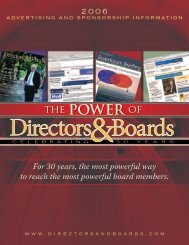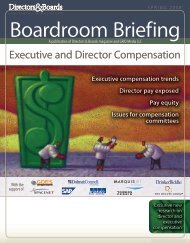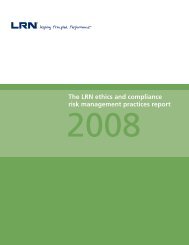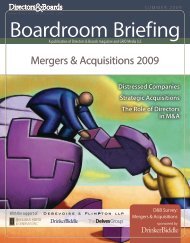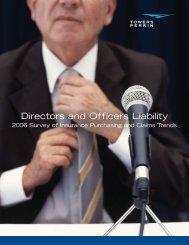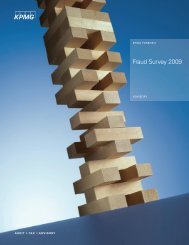Boardroom Briefing: Mergers & Acquisitions - Directors & Boards
Boardroom Briefing: Mergers & Acquisitions - Directors & Boards
Boardroom Briefing: Mergers & Acquisitions - Directors & Boards
Create successful ePaper yourself
Turn your PDF publications into a flip-book with our unique Google optimized e-Paper software.
Second Opinion on Fairness Opinions<br />
By Bruce Bingham<br />
Opinions of value can provide the board with another level of M&A due diligence<br />
A<br />
fairness<br />
opinion<br />
prepared<br />
by a party fully<br />
independent to<br />
the transaction<br />
should leave<br />
no doubt that<br />
a director has<br />
Bruce Bingham covered all<br />
professional and legal bases. But in<br />
today’s environment, how safe is safe?<br />
In order to prove that a director has<br />
met his or her obligations under the<br />
business judgment rule in today’s<br />
expanded litigious environment, that<br />
director must be adequately informed<br />
before making any decisions. Because<br />
of the increased scrutiny given to<br />
fairness opinion independence, more<br />
and more directors and their legal<br />
Opinion of Value<br />
What is the difference between a<br />
fairness opinion and an opinion<br />
of value? While the analytical<br />
processes are quite similar, the big<br />
difference is that an opinion of value<br />
does not include an assessment<br />
on the part of the valuator as to<br />
whether or not a transaction is<br />
fair to a party to a transaction. As<br />
such, an opinion of value leaves the<br />
determination of fairness solely to<br />
the directors and, therefore, provides<br />
less protection to the board.<br />
Next, a valuation firm will typically<br />
apply approaches to value and<br />
professional valuation standards<br />
that are mandated by the Uniform<br />
Standards of Professional Appraisal<br />
Practice (USPAP). This set of standards<br />
business are the market approach,<br />
the income approach, and the cost<br />
approach; all of which use different<br />
sources of quantitative data that<br />
result in indications of value.<br />
The cost approach considers the net<br />
asset value, and is relevant primarily<br />
to holding companies and asset<br />
intensive businesses. The market<br />
approach is an ex ante valuation<br />
looking back at publicly available<br />
historical data of comparable<br />
companies to correlate performance<br />
into indications of value. The<br />
income approach is forward looking,<br />
using company prospective financial<br />
information to get to a net present<br />
value indication. The results of<br />
the individual approaches are<br />
then reconciled into the opinion<br />
of value. Many investment banks<br />
Increasingly, boards are seeking a higher level of due diligence, thus soliciting the help<br />
of independent valuation firms to perform either a second, parallel fairness opinion or<br />
prepare a business valuation opinion for the private use of the board.<br />
counsel are concerned that the legal<br />
requirement of being adequately<br />
informed should not rely simply on<br />
having a fairness opinion, but in<br />
making sure that its creation was<br />
truly independent of any financial<br />
beneficiaries to the transaction.<br />
Increasingly, boards are seeking a<br />
higher level of due diligence, thus<br />
soliciting the help of independent<br />
valuation firms to perform either a<br />
second, parallel fairness opinion or<br />
prepare a business valuation opinion<br />
for the private use of the board.<br />
is promulgated by The Appraisal<br />
Foundation’s Appraisal Standards<br />
Board, founded in 1987 as one of the<br />
Federal government’s responses to the<br />
savings and loan crisis.<br />
USPAP mandates consideration of<br />
each of three traditional approaches<br />
to value, and, if information exists<br />
with which to apply an approach,<br />
that approach must be utilized<br />
unless clearly not applicable. The<br />
three methods commonly used to<br />
arrive at an objective opinion of<br />
value for the acquisition or sale of a<br />
use aspects of these approaches<br />
such as a discounted cash flow or<br />
performance multiples (price to<br />
earnings, etc.), but they may not<br />
go through each approach in its<br />
entirety, thereby possibly missing a<br />
key piece of the analysis.<br />
Analytical Comfort<br />
The analytical capabilities of<br />
valuators may also be of valuable<br />
service to a board. A major source<br />
of comfort in bringing in<br />
(continued on page 49)<br />
2 8 B o a r d r o o m B r i e f i n g : M e r g e r s & A c q u i s i t i o n s


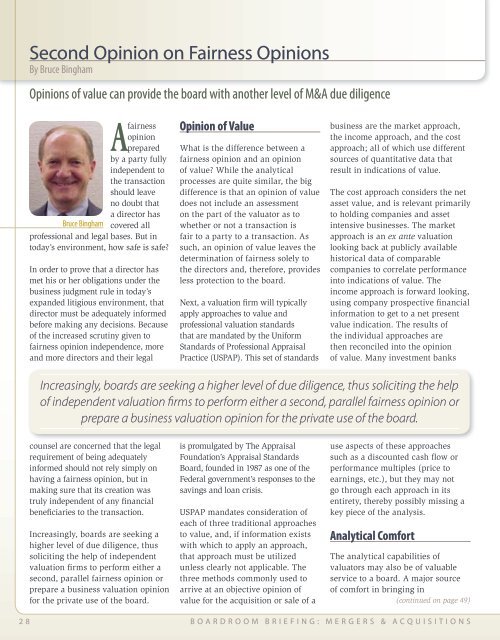
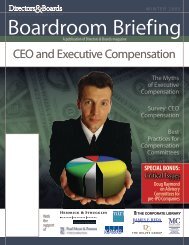
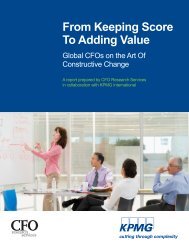
![[link to PDF] for a copy of the briefing paper - Directors & Boards](https://img.yumpu.com/43729022/1/190x245/link-to-pdf-for-a-copy-of-the-briefing-paper-directors-boards.jpg?quality=85)
